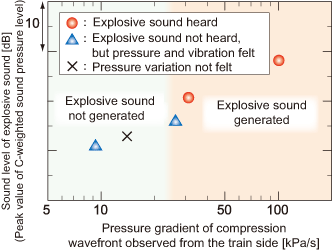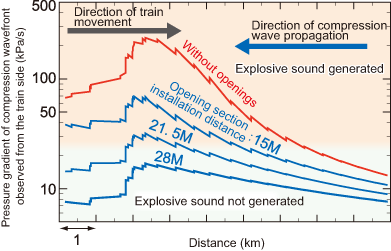2. Countermeasures to reduce interior explosive sound inside a slab-tracked tunnel
- RTRI gained more insight into how interior explosive sound is generated when a Shinkansen train encounters a compression wave inside a slab-tracked tunnel.
- It demonstrated that countermeasures to reduce micro-pressure waves (e.g. tunnel entrance hood) were also effective for reducing the interior explosive sound.
When a Shinkansen train running in a long slab-tracked tunnel meets a compression wave generated by an oncoming train and propagated in a tunnel, the high-frequency components of the compression wave are transmitted to the inside of the vehicle which may generate interior explosive sound (Fig. 1). Accordingly, RTRI measured this explosive sound and the compression wave propagating in the tunnel at the same time. The mechanism which produces the interior explosive sound and countermeasures for its reduction were also investigated.
The results demonstrated that in a long slab-tracked tunnel, a steep compression wavefront is generated. This, when encountered by a train, produces sharp peaks of sound pressure inside the train which are perceived like the sound of an explosion. Investigation of the relationship between the level of this explosive sound inside the vehicle and the gradient of the compression wavefront as observed from the train side clarified that the explosive sound is generated inside the vehicle when the pressure gradient of the compression wavefront exceeds about 25 kPa/s (Fig. 2).
The pressure gradient of the compression wavefront generated by a train entering a tunnel can be reduced by the same countermeasures used to reduce a micro-pressure wave, such as a tunnel entrance hood. Accordingly, the effect of openings installed at the tunnel entrance was investigated using numerical simulation on the basis of the measured train and the tunnel (Fig. 3). The results showed that the pressure gradient of the compression wavefront observed from the train fell below 25 kPa/s in all sections of the tunnel, and that the interior explosive sound inside the vehicle can be prevented by implementing countermeasures aimed at entry into the tunnel of an oncoming train.
 Fig. 1 Phenomenon of the interior explosive sound inside a vehicle
Fig. 1 Phenomenon of the interior explosive sound inside a vehicle Fig. 2 Relation between the sound level of the explosive sound inside a vehicle and the pressure gradient of the compression wavefront
Fig. 2 Relation between the sound level of the explosive sound inside a vehicle and the pressure gradient of the compression wavefront Fig. 3 Effect of countermeasures at the stage of entry of oncoming trains
Fig. 3 Effect of countermeasures at the stage of entry of oncoming trains